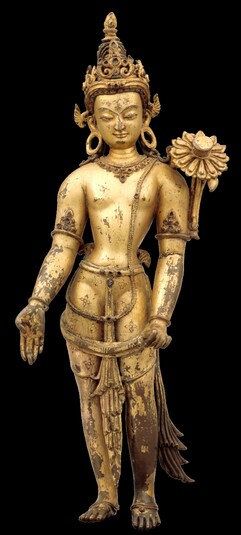
Item: Avalokiteshvara (Bodhisattva & Buddhist Deity) - Padmapani (Lotus Holder)
| Origin Location | Nepal |
|---|---|
| Date Range | 1200 - 1299 |
| Material | Metal |
| Collection | Rubin Museum of Art |
Alternate Names: Lokeshvara Avalokita Lokanata Lokanatha Mahakarunika
Classification: Deity
Appearance: Peaceful
Gender: Male
Padmapani Avalokiteshvara.
Padmapani (lotus holder) is a Sanskrit term referring to Lokeshvara, the bodhisattva, having one face and two hands. The left hand holds the stem of a blossoming lotus flower. The textual inspiration for the imagery of Lokeshvara in this appearance are the Sutras of the Mahayana tradition of Buddhism. Padmapani is also used as a synonym for Lokeshvara. The term is commonly found as an epithet, as well as a descriptive term, referring to the lotus held in the left hand. It has yet to be shown or proven textually that there is any specific and unique form of Lokeshvara accepted across the Indian Buddhist cultural sphere that is described in early literature as a Padmapani Avalokiteshvara.
(See longer definition page).
Jeff Watt [added 1-2021]
Exhibition: From the Land of the Gods: Art of the Kathmandu Valley
Exhibition: RMA Masterworks, January 28th, 2021
Publications
Publication: Selection of Works - Sculpture (RMA)
Thematic Sets
Collection of RMA: Best of Collection (Sculpture)
Sculpture: Metal
Buddhist Deity: Avalokiteshvara, Padmapani (Masterworks)
Nepal: Early Malla Period Sculpture
Collection of Jourdan-Barry
Collection of Rubin Museum of Art: Avalokita (Sculpture)
Collection of RMA: Best of Collection 1
Collection of RMA: Selected Sculpture
Collection of Rubin Museum (Nepalese Sculpture Masterworks)
Buddhist Deity: Avalokiteshvara, Padmapani (Standing)
Buddhist Figure: Bodhisattva Art Definition
Collection of Rubin Museum of Art: Sculpture (Gallery 1)
Subject: Iconic & Non-iconic Figures Main Page
Buddhist Deity: Avalokiteshvara Masterworks (Sculpture)
Collection of Rubin Museum of Art: Nepal

